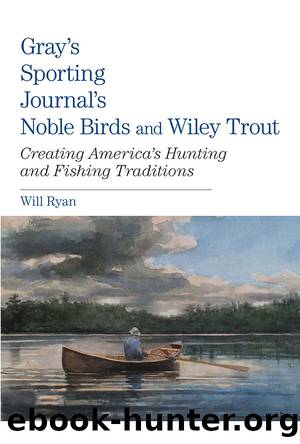Gray's Sporting Journal's Noble Birds and Wily Trout by Ryan Will;

Author:Ryan, Will;
Language: eng
Format: epub
Publisher: Lyons Press
Published: 2013-12-17T00:00:00+00:00
âIt Depends upon His Heartâ
Bliss Perry
âFishing with a Worm,â The Atlantic Monthly, 1904
When Shorty prowled the banks of the 1880s Pleasant Stream, the brook trout was the only trout. Tales of five- and six-pounders from Maine lakes drew trains of sportsmen north. In rivers closer to civilization, brook trout continued to decline in numbers and size through the period. In the mid-1880s, brown trout were introduced to Eastern rivers, most notably in the Catskills, and fly fishing would never again be the same.
Still, for many American anglers, brook trout fishing with worms continued to anchor their daily lives, which by all reports increasingly felt adrift as the pace of living accelerated with the new century. Even today, a good day of fly fishing for rainbows and browns can make you feel skillful or accomplished, but a good day with brookies leaves you feeling like you are where you belong.
Worm fishing was a way of life for generations of Eastern brook trout anglers, in large part because of the environs that sustained the native trout. Brush-thatched trout trickles accommodated whatever equipment a nineteenth-century boy could whittle or steal, and the hidden worlds and fontinalis treasures worked their magic on the imaginations of young and old. Authors might have written of fly fishingâs grace, but most nineteenth- and early twentieth-century anglers remained intent on a full creel, or âfishing for count,â as it was sometimes called.
By the turn of the twentieth century, the steady harvest and vanishing forest had further reduced the brook troutâs range, as well as limited the size of the fish within that range. The allure of small streams lingered, however, and, if anything, grew as the industrializing nation left the native trout behind in the countryside of its youth. Brook trout remained the connection to pre-contact America, to wilderness. North America was the brook troutâs home.
Fly fishing for brown and rainbow trout came into such vogue in the early twentieth century, and with it the criticism of worm fishing that it was too easy, that none other than The Atlantic Monthly published a 1904 feature article titled âFishing with a Worm.â In some ways this story responded to the ever-present gap between what goes on in print and what goes on astream. In this case the author was the magazineâs editor, an eminent scholar named Bliss Perry. He rose to defend the worm, arguing for its facility in catching trout in brushed-over streams, celebrating the skill and sport that such a venture entailed. âThere are some fishermen,â Perry noted, âwho always fish as if they were being photographed.â His article, he explained, was not for them.
Perry set the story on a thread of black water that wound through the tangles of northern Vermont, a stream so small and wooded that you sometimes had to fish by sound. âThe trick,â Perry explained, âis to shorten your line to two feet or even lessâ and then ease the worm-baited hook âinto that gurgling crevice of water.â Chances are
Download
This site does not store any files on its server. We only index and link to content provided by other sites. Please contact the content providers to delete copyright contents if any and email us, we'll remove relevant links or contents immediately.
Backpacker the Complete Guide to Backpacking by Backpacker Magazine(1827)
The Isle of Mull by Terry Marsh(1523)
Capital in the Twenty-First Century by Thomas Piketty(1425)
Predation ID Manual by Kurt Alt(1316)
The Collected Non-Fiction by George Orwell(1310)
Small-Bore Rifles by C. Rodney James(1275)
Creative Confidence by Tom Kelley(1148)
Backcountry Bear Basics by Dave Smith(1134)
All Fishermen Are Liars by John Gierach(1121)
50 Famous Firearms You've Got to Own by Rick Hacker(1107)
Blood Mountain by J.T. Warren(1100)
The Art of Throwing by Amante P. Marinas Sr(1081)
Archery: The Art of Repetition by Simon Needham(1068)
Long Distance Walking in Britain by Damian Hall(1056)
Backpacker Long Trails by Backpacker Magazine(1035)
The Fair Chase by Philip Dray(984)
The Ultimate Shooting Skills Manual: 212 Essential Range and Field Skills (Outdoor Life) by The Editors of Outdoor Life(969)
The Real Wolf by Ted B. Lyon & Will N. Graves(963)
The Ultimate Guide to Home Butchering by Monte Burch(951)
